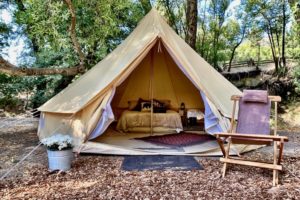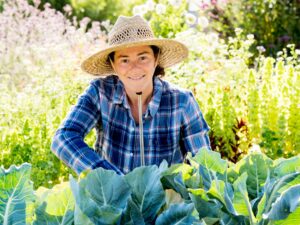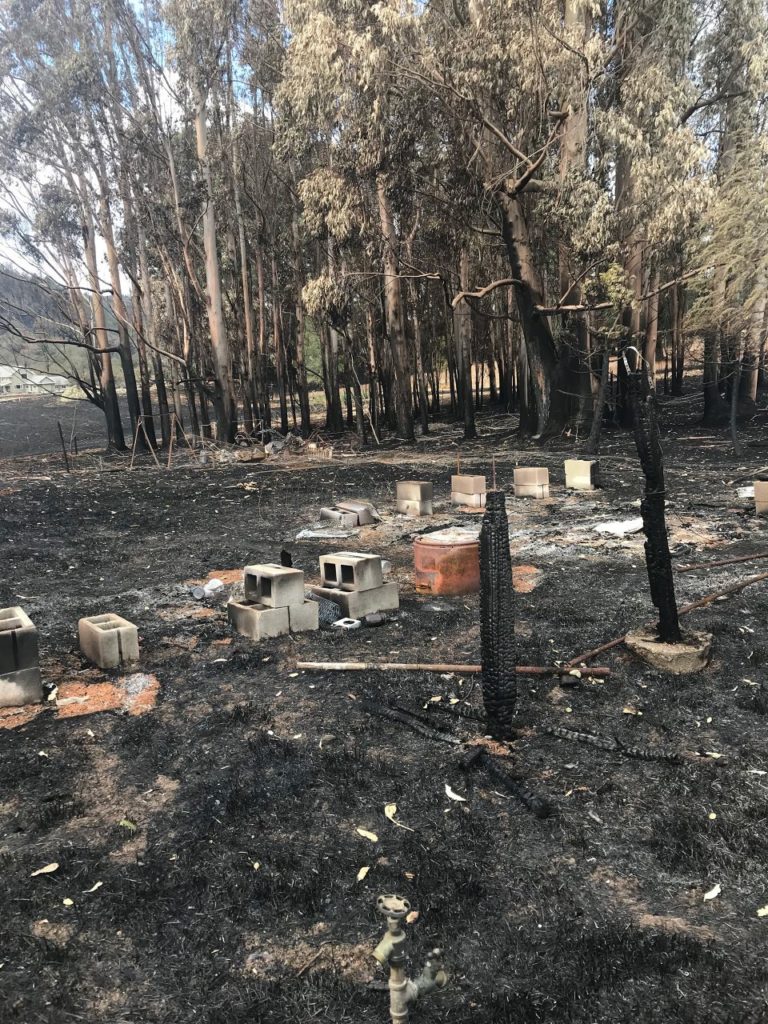Some North Bay beekeepers lost multiple hives to the North Bay fires, while others saw only behavioral changes in their bees. In the end, everyone was impacted.
On a Monday morning, just a few hours after the most devastating wildfire in California history bore down from Calistoga into the northern edges of Santa Rosa, local apiarist Dewitt Barker received a text from his friend Susy Finzell. She’d had to flee her house in the middle of the night. The house was gone. Most likely, his 25 bee colonies had perished too.
Finzell lives on 27 acres of land on the backside of Fountaingrove with views of the Sonoma Valley and the Mayacamas Mountains. For eight years, Barker, the founder of Kiss the Flower Honey Company, had kept his main apiary there, on “pirate bee ships,” his name for large moveable trailers filled with living and empty bee hives.
A few days later, Barker saw the destruction with his own eyes. The entire bee-yard had been reduced to ash. Not a single bee had survived. Nothing remained but cinder blocks and five scorched bee boxes. He cried—a big, chest-heaving cry.
“I felt such despair because I didn’t have an opportunity to run over there and try to move them,” he says. “There was no warning by the time the fire swept through. They were gone. It’s like your children; you want to protect these vulnerable creatures.”
The bees, he says, never had a chance in the face of the ferocious and fast-moving fire, which was propelled by hurricane force winds and reached temperatures high enough to melt glass and hubcaps. Plus, bees communicate through smell. With no warning, and a reluctance to fly out in the middle of the night, the bees were overwhelmed by the smoke, which impeded their usually strong ability to communicate and initiate an emergency response.
It wasn’t an easy thing to take in for someone who calls beekeeping his “spiritual practice.” After leaving a career in the music industry, Barker studied beekeeping and queen bee rearing at UC Davis before launching his company in Sonoma County. He describes himself as a treatment-free beekeeper, which means he doesn’t apply miticides, unlike most commercial beekeepers. He also has a deep interest in breeding and genetics, and mourns the loss of a decade of genetics acclimated to that specific location, calling it “a devastating loss of living colonies.”
“These were very strong bees at the point that the fires took them out,” says Barker.
Over in the Sonoma Valley, Serge Labesque has been practicing natural beekeeping for twenty years. His unconventional approach to keeping honeybees has brought him notoriety in the North Bay where he teaches classes on natural beekeeping at Santa Rosa Junior College. According to Labesque, who is originally from France, most conventional beekeeping “goes against nature” for the benefit of humans.
He handles honeybees like the wild creatures he believes them to be. “I keep the bees in mind,” he says. “Nature knows better than I do as a beekeeper. I try to respect the biology in my approach. I let the bees tell me what to do rather than forcing my intent on them.”
Labesque keeps apiaries in four locations near his home in Glen Ellen. His main apiary is at Oak Hill Farm, a small, diversified, organic and family-owned farm of Highway 12 near the Bouverie Wildflower Preserve. The fires came within a few feet of the hives, but a fire break stopped the flames in their tracks. Everything around them was consumed and turned to ash, but the hives were spared. In what Labesque calls a miracle, the hives have yet to show any physical traces of fire whatsoever, an outcome he attributes to a combination of proximity to fire breaks and plain luck. A “good season” also means that the stores of honey and pollen are abundant.
Nonetheless, the bees’ behavior indicates subtle negative impacts, perhaps stirred up by the fast-moving wildfire. Most notably, even as stores remain in top condition, the bees have shown signs of stress, mainly displayed as increased aggression. Labesque has discovered severed bee parts— legs and wings—torn away from the bees’ bodies when they move too quickly within the hive. He’s also noticed some bees engaged in a behavior called “robbing,” when a strong colony attacks a weaker colony to settle honey.
“They are extremely agitated and very defensive much more than normal,” says Labesque. “I attribute that to the density of the smoke.” Despite these worrisome behaviors, he’s optimistic that once the smoke and the odor from burned vegetation and structures subside, the bees will return to normal pre-winter behaviors. They have plenty of food and forage from stands of eucalyptus and coyote brush that survived the fire. He’s not too worried about the bees’ stores for the winter. They should have enough.
Labesque is encouraging fellow beekeepers to multiply and propagate those bees that make it through the coming winter.
“We should multiply the bees that survived the fire and make them available to all the beekeepers who had lost their hives,” he says. “If we don’t do that, we’re going to be opening the door to the introduction bees that aren’t adapted to our local conditions. As we import bees, we import not only genetic material that is unfit to our area, but also new pests and pathogens that harm our bee population.”
One animal population that doesn’t get as much attention are local feral bees. Unlike their domesticated cousins, these native pollinators don’t typically keep stores and they live a solitary lifestyle, nesting in holes and leaves on the ground. According to Jon Sevigny, a beekeeper in Napa Valley, the recovery for these bees will be slow.
“These colonies that have survived will be in competition for food,” Sevigny said in a statement posted on the Napa Valley Beekeepers Facebook page. “A lot of what they’re foraging will be concentrated where there are available food sources, like homes, gardens, and farmland.”
Vineyards offer little sustenance to the bees, which means that until replacement plants like lupine spring up, the resources will be slim. But there are ways that people can help the bees rebound. Sevigny recommends planting a diverse assortment of seasonal and winter blooming flowers as bees can travel up to three miles in search of food sources. Rosemary, lavender, mint, and other flowering herbs are popular choices—just make sure they weren’t treated with pesticides or neonicotoids, which have been tied to Colony Collapse Disorder.
He also suggests a gentle approach to gardening where leaves and underbrush are allowed to remain in place so as to prove nest locations where feral bees can overwinter. “Bees and more so, native pollinators, have been at this game since time began,” writes Sevigny. “They are resilient and resourceful. They will rebound.”
DeWitt Barker, despite the loss of 25 living colonies, shares this positive attitude. With over 60 hives spread throughout Sonoma County, he still has dozens of hives stationed on organic farms and other open spaces in Sebastopol, Graton, and parts of Santa Rosa that were unscathed by the fire.
“The bees are building up as we speak,” says Barker about his hives at Blue Lake Farms in east Santa Rosa.”Will, the farmer there, is cover cropping with buckwheat; I’m lucky to know people like him, who are doing the right thing and feeding bees during a time of the year when there is usually no nectar flow going.”
His bees also have strong, locally acclimated genetics, thanks to years of careful breeding. After refreshing his knowledge of queen bee breeding, Barker will work on building up baby colonies from his remaining hives. Urged on by a client, Good Eggs, the organic grocery delivery service out of San Francisco, Barker is putting together a loan application through Kiva, an online lending platform.
It’ll probably take about two years to build back his hives in the hills above Santa Rosa, but he’s up for the challenge.
“There’s nothing like this kind of firestorm to forge one’s will and determination to succeed,” says Barker. “I’m doubling down on my efforts to do my best with what remains, and I have a lot of confidence in the honeybees ability to generate more abundance. Because nature is regenerative; it heals itself.”
This article was originally published on kqed.org/bayareabites.
















